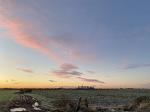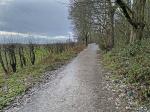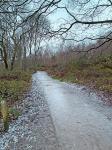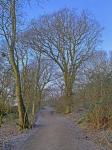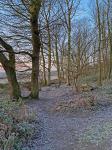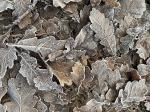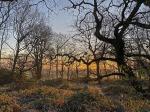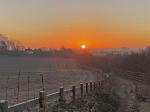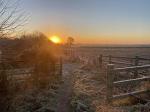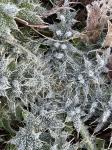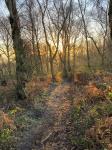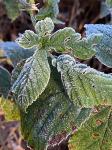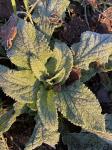Brayton Barff Through the Seasons.
Set in the Vale of York, South West of the market town of Selby and between the villages of Thorpe Willoughby and Brayton, lies Brayton Barff, a sandstone Hill approximately one hundred and fifty feet in height which was formed by glacial movement during the last Ice Age. It is a significant landmark in an otherwise flat landscape.
Today the site is primarily owned by Yorkshire Water with Selby District Council owning a small patch of the land adjacent to the A63 Selby bypass. A large underground reservoir occupies the centre of the site which delivers water to around 4.7 million customers throughout Yorkshire.
Within the Barff woodland over 40% of the trees are Sessile Oak which are generally found in semi natural woodlands in the north of the country. These trees are so called because its acorns are not held on stalks, like those of the English Oak (Pedunculate), but attached directly to the outer twigs. There are also several English Oak trees as well as some cross-hybrid oaks. These trees are known to support many species of flora and fauna, invertebrates, mosses, lichen and fungi.
During the Victorian times it is thought that the shipbuilders on the east coast would come over to the Barff for selected cuts of timber to build their sea going vessels.
The Barff also has a variety of other trees including Silver Birch, Beech, Sycamore, Holly, Rowan, Scots Pine, Alder, Hawthorne and European Larch. There are also several Yew, Willow, Hazel, Horse Chestnut and Wych Elm. As with similar woodlands there are a variety of bushes, including Honeysuckle, Elderberry, Gorse, Broom and Buddleia.
The history of Brayton Barff is quite vague, apparently during 1803 a beacon was lit on the Barff when the country was threatened with an invasion by Napoleon. In May 1935, to celebrate King George V's Silver Jubilee, a Bonfire was lit on the Barff as part of the celebrations.
Early issues of Ordnance Survey Maps dated 1903 clearly show a rifle range on the Barff, extending out to Mill Lane. During the 
Between 2001 – 2004 the A63 Selby bypass, 10km twin lane single carriageway was constructed which severed the South West corner of the Barff, adjacent to Selby Golf Course and resulted in a slight redesign of several holes on the golf course. Wooden fencing was erected as a result of this new road running alongside of the Barff and a footbridge constructed over the ‘new road’ following the line of the Bridal way which extends from Mill Lane. Around 2005/2006 a definite 2metre wide limestone aggregate footpath was laid forming a circular path around the outer edges of the woodland. This footpath is approximately 1.2 miles in length and takes about 30 minutes to circumnavigate at a leisurely pace.
In 2012 the Barff was declared an Ancient Oak Woodland and as such throughout 2012 and 2013 significant work had been carried out by the relevant agencies to cut and remove large swathes of non-native trees, creating at that time huge scars on the landscape. Some three years later the planting of the native trees have become well established and are flourishing. Ongoing maintenance work on the footpath around the bottom of the Barff was completed during the Summer of 2016.
A second phase of woodland maintenance commenced during the Autumn of 2019 with the removal of many old and diseased trees and the cutting back of the Gorse and Broom bushes, especially adjacent to the ‘bypass trail’, this work continued through till March 2020 with re planting continuing into April 2020.
Brayton Barff is a popular site for walkers and bird watchers alike and a path circling the outer perimeter of the Barff makes a pleasant thirty minute walk, giving views looking over towards Selby and the village of Brayton as well as the power stations of Drax and Eggborough..jpg)
For the early risers it is a great place to see some stunning sunrises over the villages of Brayton looking towards Drax Power Station, the same with the Sunsets looking over towards Eggborough and Monk Fryston.
The Barff changes with the Seasons and every visit can reveal something new, the woodland is a haven for wildlife. Records show that since 1982 one hundred and twelve species of bird have been seen in the woodland and at least 40 of those have bred here, including Tawny Owl, Buzzard, Green Woodpecker, Spotted Flycatcher, Goldcrest and Nuthatch to name just a few. On average over 70 species of bird are recorded each year. Further details of the bird life on the Barff can be found on the Brayton Barff Group Facebook page, especially the posts from Derek Cooper. Today ‘The Friends of Brayton Barff group’ led by Derek and a small team of volunteers help keep and maintain the cleanliness of the site as well as recording the wildlife and bird sightings.
The Barff is also home to fifteen different species of mammals, including Muntjac Deer, Pipistrelle Bat, Fox, and Field Vole.
Over eighty species of plant and wildflowers have been recorded, included Bee Orchid, Northern Marsh Orchid, Wood Anemone, Marsh Ragwort, Bluebell, White Bluebell, Bittersweet and Purple and White Foxgloves. Over twenty species of Butterfly have been recorded, including Marbled White, Brown Angus, Speckled Wood, Comma and Brimstone.
During the Autumnal months fungi thrives in this woodland environment, species including Fly Agaric, Beefsteak Tree Fungi, Chicken of the Wood, Sulphur Tufts, Stinkhorn, Ink cap, Puffballs and Hoof Bracket are just some of the many varieties that can be found here.
Click on the galleries shown below to expand the albums.
Early January 2021
Well, here we are the start of a New Year, and stuck in a Covid Lockdown again.
Unfortunately, due to the rising Covid levels across the country prior to and after Christmas, the government has re-introduced a lockdown across the entire country.
Late last year North Yorkshire was in the tier 2, whilst most of the country was in tier 3.
As I write this note, sadly in the UK over 81,000. people have now lost their lives due to Covid since the start of the pandemic. This New Year our hospitals are recording over 900 people a day losing their lives, with 30,000 patients currently being treated in hospital for Covid. This obviously is putting a tremendous strain on our hospitals and my heart goes out to those who have lost loved ones and to all the staff working in the hospitals in such stressful circumstances. A ray of hope during the Christmas period was the announcement of effective vaccine to treat the virus. Within a few days a second vaccine was approved and as I write this note a third vaccine is ready for release. Over 2.4million people have been vaccinated to date with the aim of having 15 million people vaccinated by mid-February.
The lockdown has affected us in many ways, fortunately for me I am retired with two very active dogs which enables me to spend some time outdoors, alas my photography during this time has been focused on my dog walks and what I see whilst on the daily walks. My local patch (Brayton Barff) is just over a mile from home so well within the criteria of ‘local area’.
Since Christmas we have had our first light covering of snow on the Barff, followed by some extremely cold and frosty mornings, a little rain, more ice and some beautiful sunrises.
Although still quite early in the New Year we have had some lovely morning walks, the hard frosts have frozen up the muddy puddles. On the morning of the 3rd January we woke up to a significant overnight frost, the main footpath around the woodland was almost unwalkable due to a thick layer of ice covering a large area of the perimeter footpath. Unfortunately, the colder temperatures during the first week of January meant that the ice stayed around a little longer than was welcome. Here we are during the second week of January, the ice has now disappeared, and the smaller off route trails are extremely muddy again.
Over the weekends when the road traffic is much lighter, I often extend our walk by following the bypass trail down the slope towards Mill lane, crossing the A63 bypass and following the track on the other side of the road, heading back up the slope towards the Barff.
This weekend I have been fortunate to watch a Buzzard hunting in the field adjacent to the golf course. It was still quite dusk as I approached the bird, around 7.45am, a good 45 minutes before sunrise, it was sat, motionless in a young Silver Birch tree, its eyes scanning the field for prey. Initially, from a distance I could just see its black outline in the tree, it looked like a large overweight wood pigeon, but as I got closer it was quite apparent it was a Buzzard. I stood and watched for a few minutes as it took to the wing, its underwing markings clearly identified it as a Buzzard, it flew off towards the centre of the field and after a couple of powerful wing flaps the bird was high in the air. It circled above the field for a minute or so before returning to the same tree it had been perched on before I disturbed it. We continued our morning walk along the bypass trail, crossing over the road bridge before heading back into the Barff.
The colder weather hasn’t deterred the Grey Squirrels at all, we see and watch them daily, scurrying up, down and among the tree branches, they are so agile and flexible. On the woodland floor Blackbirds can be seen and heard busily upturning all the frozen leaves in search of food, quite oblivious to myself and the dogs as we pass them by.
I’ve heard and seen several Nuthatches of late calling to each other, they have obviously over wintered here, I remember hearing them calling back in December, I’ve also been fortunate to catch sight of several Tree Creepers too, scurrying up and down tree trunks prizing out grubs from between the bark of the oak and silver birch trees. I have heard several Goldcrest too, this delicate, tiny bird with a little gold crest on its forehead tends to prefer the big holly bushes which is where I generally hear them.
I startled a Hen Pheasant on our walk earlier this week, Pheasants have really good hearing and on two occasions just recently they have flown out from the undergrowth no more than a metre away from me, as they took flight, I could feel the draft from their wings as they flew over my head into the relative safety of the field the other side of the footpath, making a noisy, high pitch croaky rattle as they fly away.
One of the main highlights as I walk around the Barff at the beginning of January have been the beautiful sunrises, accompanied by a clear dark blue sky. It starts to get light at around 7.30am with the sun rising around 8.30am. Depending on the weather conditions each sunrise is completely different, some last for seconds whist others can last up to 15 minutes.
Although still in the depths of Winter, signs of Spring are beginning to show, tiny shoots of Bluebell leaves are just breaking the soil surface, fortunately they are well covered from the elements by a thick covering of leaf mulch. The Autumnal fallen Acorns are beginning to sprout too with a tiny root breaking through the outer shell and sinking into the ground beneath. The gorse bushes around the Barff add a welcome bit of colour to the landscape at this time of year, the vibrant yellow florets brighten up the day nicely.
Looking at the weather forecast for the days ahead it looks as though a band of snow is heading our way and snow on the Barff completely transforms the landscape. Stay safe.
|


